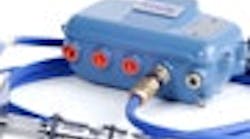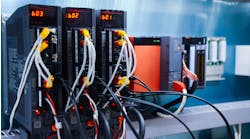More process plants are turning to online corrosion monitors to help extend equipment life and enhance operations. For instance, engineers at the 10-million-ton/yr refinery of Dalian West Pacific Petrochemical Company (WEPEC), Dalian, China, opted for such devices when they wanted to improve their understanding of the effects of processes and operational conditions on plant metallurgy.
They selected SmartCET units (Figure 1) from Honeywell Corrosion Solutions, Houston. WEPEC says the decision was based on three main factors: 1) the devices, unlike older instruments that only indicate generalized corrosion rates, provide information on localized corrosion through the pitting factor; 2) they offer additional corrosion variables that vastly improve the accuracy of the published corrosion rate and give an indication of how the corrosion mechanism changes in the process environment; and 3) WEPEC's own engineers could verify corrosion data and trends using ultrasonic thickness gauges.
In late 2009, the plant installed 11 transmitters in equipment with the highest level of corrosion risk, including the atmospheric distillation column and the condensate surge drum outlet.
Corrosion monitoring data and trends are displayed on operator consoles together with process parameters (temperature, flow, velocity, pressure) of each monitoring point. The data are shown on the same time axis, enabling the operators to correlate changes in corrosion with process conditions.
WEPEC hails the project as a complete success because plant engineers have gained a greater understanding of how process upsets affect plant metallurgy — and as a result have been able to reduce failure rates.
According to Honeywell, this success, coupled with similar results from refineries in the U.S., is generating a lot of interest from the chemical industry.
"Traditionally in the chemical industry, the corrosion problem has been dealt with on an after-the-fact/event basis. The processes used are typically very complex, as are the process chemicals, so trying to look at corrosion with any accuracy close to real time was a problem," says Sridhar Srinivasan, global business leader.
The online SmartCET technology used by WEPEC was originally trialled in a year-long project at BASF, Freeport, Texas, where 12 pilot devices found a significant correlation between the feed rate of a specific inorganic chemical and the level of corrosion in pipework. Traditional weight-loss coupons indicated corrosion of 2.965 mils/yr while SmartCET measurements showed 2.90 mils/yr. The coupons effectively validated online monitoring — so much so that BASF decided to abandon coupon use altogether.
"So we began to look at corrosion as a process variable, with the information being sent from the probe to the company DCS [distributed control system] in real time so that corrosion could be seen alongside other process variables impacting/causing corrosion," he explains.
Honeywell's latest offering, the OneWireless SmartCET range, transmits corrosion data wirelessly — a boon in areas of limited access where safety is an issue. The wireless mesh network makes adding more monitoring points easy. However, wired units still dominate, accounting for about 80% of corrosion monitor installations. "But I see a much greater growth for wireless in the future — perhaps 50/50 wireless-to-wired within five years," notes Srinivasan.
Another change he foresees is corrosion becoming more a part of plant operation and control rather than maintenance. "Online monitoring lets you integrate corrosion rate into integrity operating windows and support efficient, safe process boundary management. For example, a $2-billion refinery might spend $100 million on maintenance over its life. One way to cut down on this cost is to monitor corrosion in real time and make it part of online process control/management."
Going forward, all corrosion data will become part of the historian, he believes, enabling users to refine processes to give optimal performance. In fact, big customers such as Shell already are using such data in their online operating framework. They see deviations immediately and can adjust the process accordingly.
"We have closed the loop on correlating corrosion rates to factors that cause corrosion as the process happens. We are getting greater accuracy and a proactive response to a specific operational target. All this feeds into the need for improving safety, reliability and, most importantly, efficiency — as a foundation for maximizing profit," says Srinivasan.
NOT TREADING WATER
Two groups of major customers — large petrochemical plants and refineries that use inhibitors in their water supplies to prevent problems such as corrosion, biofouling and particulate buildup, and water-treatment-service vendors that must document whether corrosion is under control in cooling water circuits — have prompted developments at Pepperl+Fuchs, Twinsburg, Ohio.
The company has introduced CorrTran MV (Figure 2), which is aimed at the chemical and oil and gas markets, and CorrTran Aqua for cooling tower users. In addition, a wireless data logger called the CorrTran Electronic Coupon is due out in the first quarter of 2012. It is battery operated and requires no programming. Users simply remove it from the process after a specified period of time and access the data via an SD card.
Overall, these products aim to improve process-to-corrosion correlation. "This is important because it allows correlation of events that are not easy to understand. The traditional coupon is essentially a linear measure of mass-loss-through-lifetime of a system. CorrTran's strength is that it takes a reading every 20–30 minutes, or every four minutes for generalized corrosion applications. That means we can look at data with respect to the rest of the process, i.e., see which process upset (such as pump calling, flow rate change, etc.) caused the rate of corrosion to change. It also allows users to do some work in the inhibitor area," says Mike McElroy, business development manager.
At one chemical plant, CorrTran is used to monitor the boiler supplying steam to the entire site. Inhibitor in the water must be strictly controlled because if too much is deposited on the heat exchanger surfaces then their properties can change. "… This customer lost two to three heat exchangers over a three-year period because corrosion caused perforations in the heat exchanger tubes, which allowed process chemicals into the steam system. Since CorrTran was installed three years ago, this chemical manufacturer has not lost one heat exchanger. So there's been a real payback," says product manager Mike Mendicino.
CorrTran Aqua also is helping in the development of inhibitors themselves. Designers can see very quickly if a new inhibitor is working.
LANDING MORE BUSINESS
Roxar Flow Measurement, Trondheim, Norway, a unit of Emerson Process Management, which historically has focused on monitoring corrosion in offshore oil production operations, is gaining ground at chemical plants, notes Kjell Wold, commercial manager. The variety of processes used in the chemical industry rules out a single solution, he adds.
Strong demands for improved data quality and more simplified ways of collecting [data] are driving the increasing interest, he says. "… People are happier with wireless these days and it gives you so much flexibility. There's been a definite change in attitude in terms of accepting wireless."
In response, Roxar has launched a new range of CorrLog wireless corrosion transmitters. These provide corrosion data in two formats: either directly to the control room as a metal loss value (due to corrosion or erosion), or as raw data through the company's Fieldwatch software. "This would be the preferred format for corrosion and production engineers but it depends on the business priorities."
The system's data logger comes with a 20-m cable. "This means that you can find the very best place in the plant for the transmitter," says Wold. Such flexibility can eliminate having to erect scaffolding when a battery or probe needs changing, he explains. Also, it can provide a way to avoid areas in shadow in a plant's wireless mesh network.
In mid-September, the company introduced Fieldwatch 3.0 (Figure 3). One of its roles is to reduce the number of false alarms received from erosion probes. During testing on historical data from the North Sea, the smart alarm software suppressed 99% of the false alarms and retained 100% of the genuine ones.
Fieldwatch 3.0 also enables installing virtual erosion sensors within a production system — these are particularly handy for monitoring bends, tees and reducers in areas where it's difficult to deploy physical sensors. Users configure the geometry and input pressure and temperature values that best represent the virtual sensor's position and analyze as they would with physical sensors, although the accuracy isn't as great.
"Using the data analysis features of Fieldwatch 3.0, decisions on optimizing flow velocities can be made… There's a similar use with chemical inhibitors: knowing when and how much to inject, for example. So, it gives much better process control. That's the beauty of the system because you can see and follow the corrosion at a nanoscale, before any damage appears on the pipes. So with continuous monitoring you can correlate corrosion rates with process changes such as, for example, water content and pH," adds Wold.
Seán Ottewell,Editor at Large, can be contacted via

